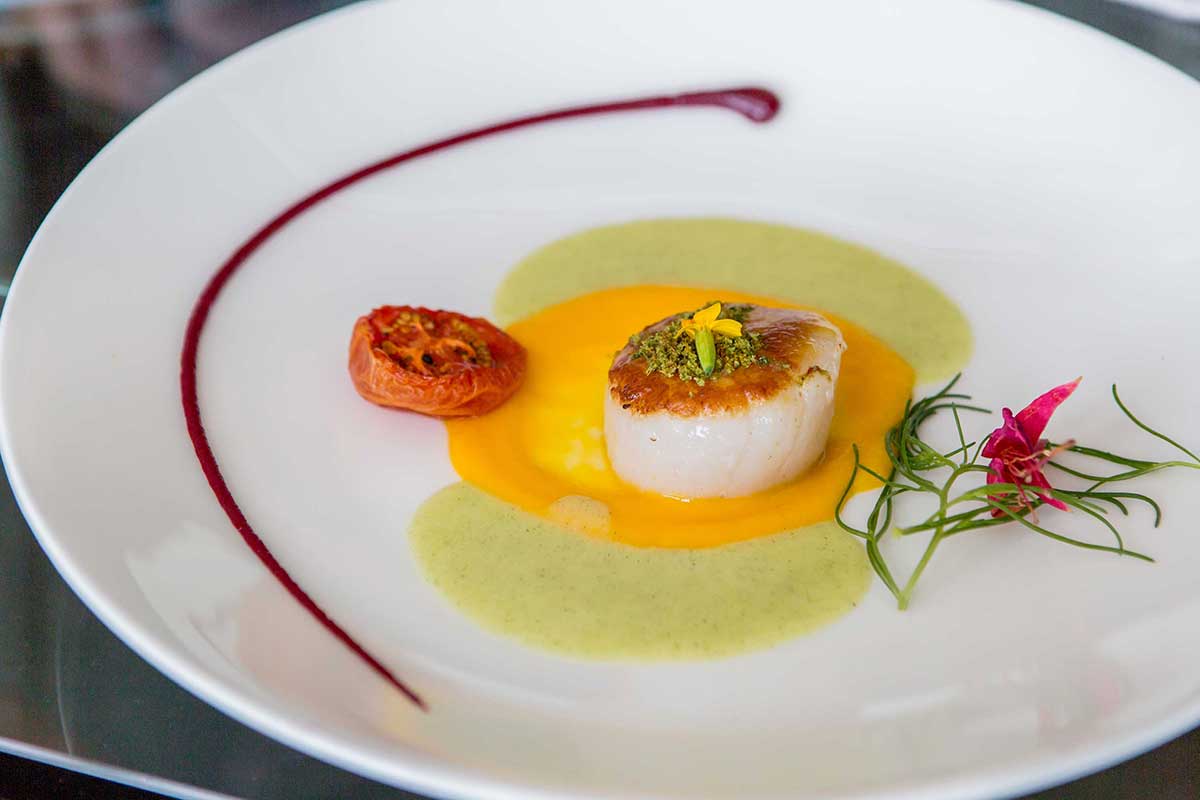OCEAN 101: A FRENCH MASTER CHEF’S GUIDE TO UNDER THE SEA
Beneath the surface of our azure waters lies an entire universe of marine life and edible treasures. Nothing tastes as pure and delicious as seafood plucked straight from its native waters.
Whether it’s sweet crab, raw tuna, buttery diver scallops, or freshly-shucked oysters, seafood boasts an expansive array of potent and altogether scrumptious sensations. These unique qualities are reflected in the diets and food cultures of the world’s coastal communities.
It is ideal to present fish and shellfish early in a meal’s progression, when lighter, palette-teasing dishes are most welcome. Many cooking methods showcase the natural flavors of seafood. Curing adds saltiness while infusing the aromas of blended herbs and spices. Smoking adds an underlying warmth and richness. Pickling contributes a pronounced brightness and tart intensity. All of these processes were developed as preservation techniques in times when refrigeration was not an option. What was invented out of necessity is now practiced almost purely for pleasure!
Freshness, quality, and safety are paramount when purchasing seafood. To ensure you get all three, it’s important to seek out reliable sources. Once you’ve located a quality fishmonger, get to know them. They have their fingers on the pulse of the local waters, knowing which fish and shellfish are in season. Ask them which varieties represent the best of each day’s catch. You’ll gain a friend in the business and the peace of mind that you have the absolute freshest, best-tasting seafood possible.
Here are all of the fish categorized by their characteristics:
- Large Flake – seabass, striped bass, snapper, halibut, grouper, orange roughy, bluefish, cod, salmon
- Thin and Delicate – sole, fluke, flounder, john dory, orange roughy, trout
- High Oil Content – salmon, trout, arctic char, steelhead, cod, pompano, pomfret, mackerel, yellowtail, kampachi, tuna, oysters, mussels, sardines, anchovies
- Shells – clams, cockles, mussels, scallops
- Meaty – mahi mahi, monkfish, swordfish, shark, tuna, yellowtail, ono, scallops
- Sea Creatures – octopus, squid
- Sweet and Nutty – shrimp, lobster, crab, scallops, oysters, monkfish
Here are our favorite fish and shellfish for each cooking method:
- In the Raw – tuna, kampachi, salmon, yellowtail, scallops, shrimp, mackerel, arctic char, halibut, oyster, clams, ono
- BBQ friendly – swordfish, mahi mahi, tuna, salmon, yellow tail, shrimp, lobster, halibut, shark, scallops, squid, octopus, ono
- Slow Cooked – monkfish, stuffed squid, salmon, swordfish, cod, stuffed sole, mackerel, octopus
- Smoked – arctic char, trout, salmon, cod, tuna, swordfish, mackerel, yellowtail, kampachi, mussels, oysters, scallop, ono
- Deep Frying – shrimp, squid, oysters, grouper, orange roughy, sole, shark, salmon, john dory, mahi mahi, halibut, cod
- Oil Poached – arctic char, cod, halibut, salmon, swordfish, tuna, yellowtail, kampachi, lobster, scallops, shrimp, ono
- Liquid Poached – halibut, fluke, scallops, shrimp, lobster, octopus, salmon, flounder, orange roughy
- Kebabs – mahi mahi, monkfish, salmon, shark, swordfish, tuna, grouper, yellowtail, squid, octopus, shrimp, scallops, ono
- En Papillote – sole, fluke, flounder, halibut, salmon, arctic char, striped bass, cod, pompano, john dory, salmon, swordfish, orange roughy, trout
- Steamed – salmon, fluke, grouper, orange roughy, shrimp, clams, cockles, mussels, crab, lobster, oysters, bass, halibut, john dory, snapper, sole, flounder, cod
- Pan Roasted – arctic char, bass, striped bass, cod, halibut, pompano, monkfish, salmon, shark, swordfish, tuna, snapper, sole, flounder, fluke, grouper, orange roughy, scallops, shrimp
How to Select and Store
When it comes to fish – Think cold!! Seafood is very sensitive to temperature. When buying fish we recommend having a small cooler with ice packs to keep safe temperature during transport. At home, refrigerate your purchase immediately at 34 – 38 degrees Fahrenheit. Try to buy fish the same day you will cook it. Trust your senses when shopping and look for these signs of freshness:
Fish
- Has clear eyes that are not sunken
- Has bright red gills
- Flesh is tight and springs back to the touch
- Flesh is vibrant in color with no discoloration
- Skin is glistening and moist
- Smells fresh like the sea with no ammonia or strong odor
- Whole fish is displayed in ice, fillets and steaks are displayed on ice
Fish should be patted dry with absorbent paper, tightly wrapped with plastic wrap and stored on ice. Do not allow fish to sit in water or even in its own natural moisture.
Shellfish
- Shells are tightly closed
- Bins of shellfish have an information tag with origin and harvest date
- No cracked or broken shells
- Tap test – slightly opened shells close up when tapped
- Has pleasant smell of the sea
- Oysters have creamy color and clear liquid when opened
Store shellfish loosely in an open container then cover with damp cloths or paper towels. Place a bag of ice loosely atop. Do not store live shellfish in a sealed container or in water.
Live Crab, Shrimp and Lobster
Are alive and kicking – literally, must have moving legs
Store loosely in an open container that they can’t escape from, then cover with damp cloths or paper towels. Place a bag of ice loosely atop. Do not store in a sealed container or they will die.
Shrimp tail, crab meat, lobster tails
- Has uniform light colored tail
- No discoloration, sliminess, or strong smell
- No black spots on the flesh
- Have whole shells that are not damaged
As a rule consume as soon as possible after purchase, but not later than 48 hours. Rinse shrimp and lobster under cold running water then pat dry before cooking. Crabmeat from a can should be transferred to a non-reactive container after its opened.
See Bernard Guillas at:
Ocean-to-Table Rosé Wine Lunch
South of France Wine Dinner Experience





